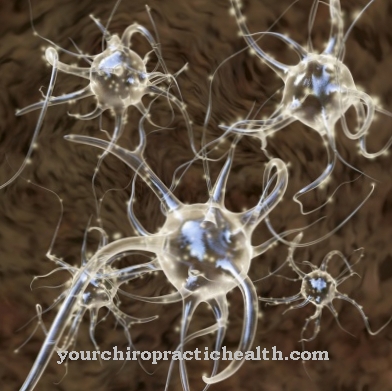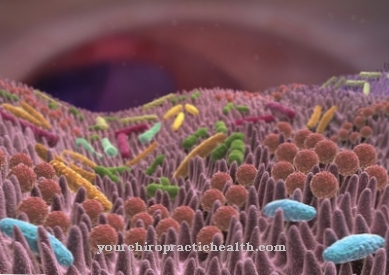Of the Hormonal balance describes the interaction of all hormones in the body. It is controlled by the hormonal system. Disorders in the hormonal balance can lead to serious illnesses.
What is the hormonal balance?

The body's hormonal balance is controlled by regulating mechanisms within the hormonal system. It is characterized by the interaction of all hormones. However, depending on the body's functions, normal fluctuations in the hormone level of individual hormones always occur.
Hormones are the body's own messenger substances that regulate important bodily functions. Their formation is controlled and regulated by a regulating mechanism within the hormonal system. Certain hormones are responsible for the energy metabolism. Others regulate the primary and secondary sexual characteristics.
The blood sugar level is controlled, for example, by the hormone insulin. Growth is also subject to hormonal influences through the growth hormone. Likewise, the body's water and mineral balance cannot be regulated without hormones. Even emotions and behavior are influenced by hormonal processes.
The production of hormones that control physical processes is in turn regulated by other hormones within the framework of the endocrine system. In order to coordinate the physical processes with one another, there are constant changes in the hormone levels of individual hormones. The hormone levels fluctuate within certain limits. When the limits are exceeded, the entire hormonal balance is disturbed.
Function & task
The hormonal balance in the body is regulated by the hormonal system. Every day, all hormones in the body are subject to concentration fluctuations, which in turn are dependent on physical processes. For all hormones, however, there are mean values around which the concentrations fluctuate.
The hormones are produced in the body's endocrine glands or dispersed endocrine cells. The endocrine organs include the Langerhans cells in the pancreas, the thyroid, the parathyroid, the pineal gland, the adrenal glands, the Leydig cells in the testes, the ovarian follicles in the ovary and, above all, the pituitary gland.
The pituitary gland, also known as the pituitary gland, is the higher-level organ of the endocrine system. It produces many different hormones with different chemical structures and functions. Some of your hormones, like growth hormone, have a direct effect on the organs or regulate the production of other hormones in the downstream endocrine glands.
The adrenal glands produce adrenaline, noradrenaline and the steroid hormones cortisol or aldosterone. Adrenaline and noradrenaline are short-term stress hormones that quickly release energy from glucose. Cortisol is a long-term stress hormone that generates glucose through the breakdown of protein in the body and thus increases blood sugar levels. The increase in blood sugar levels in turn increases the production of insulin in the pancreas. Insulin works by transporting blood sugar into cells.
The thyroid produces the thyroid hormones that stimulate the metabolism. Metabolic processes would no longer be able to take place without thyroid hormones. The parathyroid gland produces the parathyroid hormone. The parathyroid hormone is responsible for the calcium metabolism. It ensures the absorption of calcium from food.
Furthermore, the sex hormone testosterone is produced in the Leydig cells of the testicle and estrogens are produced in the ovarian follicles of the ovaries.
As part of the normal hormone balance, the hormone concentrations are subject to constant fluctuations within certain limits. With physical changes through growth, during puberty or during menopause, the hormonal balance also changes drastically. These phases represent normal transition phases, each of which leads to different hormonal equilibrium states.
During these changes there can be such strong fluctuations in the hormonal balance that even physical complaints occur. As a rule, however, these complaints do not require treatment, as they occur within a normal process of change in the hormonal balance.
Illnesses & ailments
However, changes in the hormonal balance can also indicate serious illnesses. For example, some endocrine organs can over-function or under-function. One example is the overactive adrenal gland with an increased production of cortisol. This hyperfunction is often caused by an adenoma or tumor.
The adrenal glands produce the cortisol autonomously without being influenced by a higher-level endocrine organ such as the pituitary gland. The result is the so-called Cushing's syndrome with trunk obesity, full moon face, hyperglycemia and a weakening of the immune system.
The hyperglycaemia in turn causes an increased production of insulin in order to lower the blood sugar level again. In Cushing's syndrome, for example, the cortisol level and the insulin level are constantly increased. Cortisol causes the body's own proteins to be permanently broken down into glucose, which is channeled by insulin into the fat cells for fat synthesis.
Pituitary disorders can upset the entire regulatory mechanism of the hormonal system. If the pituitary gland fails, many hormones are no longer or not sufficiently produced. One example is the so-called Sheehan's syndrome, which is caused by necrosis of the pituitary gland as part of a pregnancy complication. A deficiency of many hormones occurs, which leads to a serious illness with many different symptoms.
Another example of a hormone deficiency disorder is Addison's disease. This is the failure of the adrenal glands. This leads to a deficiency in the hormones cortisol and aldosterone. The result is a disruption of the mineral metabolism and hypoglycaemia (low blood sugar) with a feeling of weakness, nausea and vomiting as well as weight loss. As part of this disease, a life-threatening Addison's crisis can occur that requires rapid treatment. Treatment consists of lifelong replacement of cortisol and aldosterone.
If the hormone balance of the sex hormones is too low, the gonads (testicles or ovaries) become underactive with a disorder of sexual function or infertility.



























